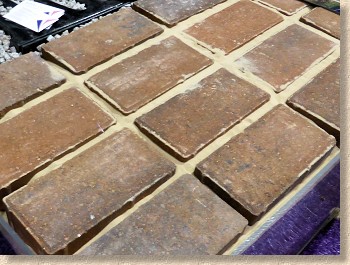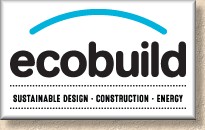EcoBuild 2015
I've lost count of how many EcoBuild's I've allowed myself to be talked into attending over recent years. Probably into double figures by now and with each passing year, the sense of it all being more trouble than it's worth, from a hard-landscaping point of view, grows stronger. It's too enormous to take it all in; it's too much of a slog out to Docklands in that London; it has an inexorable drift towards corporate glad-handing and content-free froth; its' relevance to the groundworks side of the building trade diminishes with every visit. But still I go!
Why? Probably because there is nothing comparable at the moment and being the eternal optimist, I cling to the belief that one year, maybe this year, it will have something, anything, that warms and reassures me on the long journey back to civilisation with the thought that, actually, it was all worth it.
2015 isn't that year, sadly. Oh, there were highlights, but these were largely chance encounters with old chums and colleagues from years gone by, and a few entertaining new introductions, but in terms of what was there to see and learn and experience, there was precious little.
For a show which claims to promote good design and product sustainability (see logo above), is it too much to expect a badge system that actually fits inside the plastic sleeve dangling from the obligatory yet non-returnable lanyard? It doesn't bode well when you see crowds of newly arrived visitors frantically folding and re-folding their paper entry badges to cram them into the transparent holders without obscuring their name, position, business and all-important barcode (we really are just numbers: illegible numbers!).
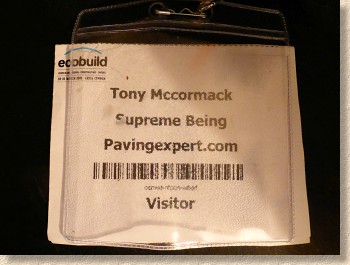
An initial perusal of the exhibitor list reveals a possible thirty-one stands that would be worth a visit, and of that thirty-one, just six where I really expect to see something of merit. So, while the Charcon/Aggregate Industries display is exactly as expected, all promising slogans and suits greeting other suits, the far less grand Interpave spot offered much more substance, if only in the form of free bottles of water, which were being grabbed by passers-by almost faster than the display could be re-stocked.
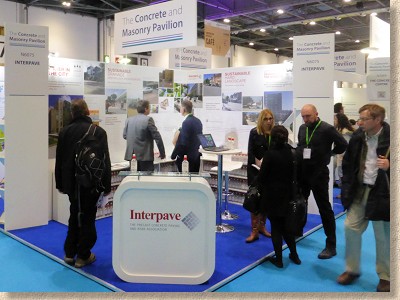
The idea behind giving away free liquid refreshment was to promote consideration of water in the design of the built environment, and, hopefully, the important role that can be played by permeable block pavements (CBPP). A worthy message, and a clever way of drawing visitors onto the stand, but, as should only be expected, the overwhelming majority of bottle-baggers had no interest in water, block paving, recycling, suds or anything other than a free drink. Still (and the water was), if only one in twenty takes the time to discuss the potential for CBPP and the critical role it will play when the forthcoming planning regulations come into force, then that has to be considered well worth it. And it was, without doubt, the busiest Interpave stand I've ever witnessed at a trade event. Mission accomplished.
A couple of relatively interesting (when compared to the rest of EcoBuild) drainage items caught the eye. Aco , long a by-word for linear surface drainage, has a new and/or revamped range of gratings for residential projects and a similarly appealing range for the public realm. Each has a touch of design class which, unless you went for a specialist bespoke supplier, haven't been readily available up to now. Too many paving projects have been let down by the inclusion of cheap, tinny gratings or deathly boring slot covers, but now there really is no excuse.
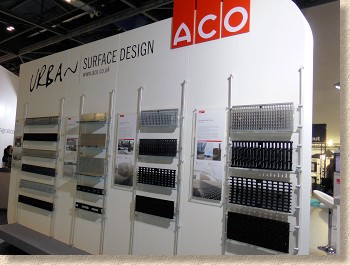
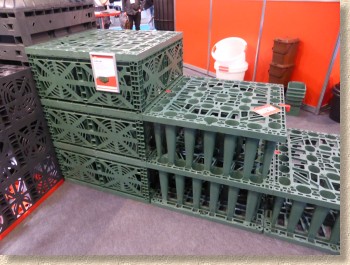
And Graf UK , a manufacturer of rainwater harvesting, drainage and suds products have a new, lightweight, space-saving attenuation crate , which comes as a sort-of flat pack, with dozens of cubic metres of storage delivered in just a few square metres of floor space. Simple, rotate-and-click construction turns the flattish-packs into tough crates capable of taking vehicle overrun and offering up to 98% void space. Damned clever!
Precious little else to see in the North Hall. An ineffective mini-display from Hanson Formpave - visitors expect more than a handful of block slips stuck to the walls – and trying to find someone, anyone, on the Mapei stand capable of discussing products suitable for the installation of porcelain paving was akin to playing a game of Guess Who. The initial Mapster off-loaded me onto a 'senior colleague' who sent me over to the guy in a blue suit who said I needed to talk to your man with the trendy beard, who wasn't 100% sure but promised to send some info once he got back to the office. That's all right then.
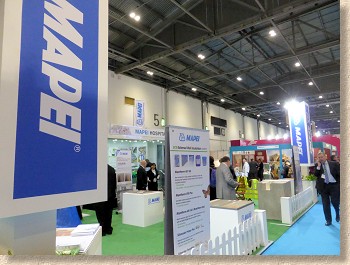
A 20-minute game of musical reps to learn nothing of consequence, to be palmed off with the vague promise of the same info I probably already have. No opportunity to discuss the whys and wherefores, which is what I hope to get from a visit to an event such as this. I want to talk to someone who can tell me the reasons for using this product in preference to that, and why I should never even think of using such-and-such a solution. I can (and have) read all the leaflets, brochures, flyers, PDFs and web-pages: what I want is an in-depth discussion with someone in the know. Isn't that what an event such as this should offer? Face-time, as I think it is now called.
More interest in the South Hall, and an unexpected little gem in the form of Hazotte , a Belgian exporter with access to some truly delicious reclaimed sett paving. The Belgian Blue limestone square setts (roughly 150x150mm in plan) are bound to attract attention, but for me, the real stars are the reclaimed porphyry rectangular (roughly 150x100mm in plan) setts, which are work to a degree of near perfection, arrisses softened with wear, muted colours, and more than enough rugged, weather-beaten charm to lift them well above the average reclaimed sett. They are also offering square sandstones setts and rectangular granites, but we're not exactly short of them in Britain. However, what might just make them more interesting is the price: 25-30 quid per square metre is a bargain, and even if you factor in the shipping from Belgium, anyone in SE England is looking at a cost that could well be lower than that involved in bring similar stones down from Scotland or the North of England.
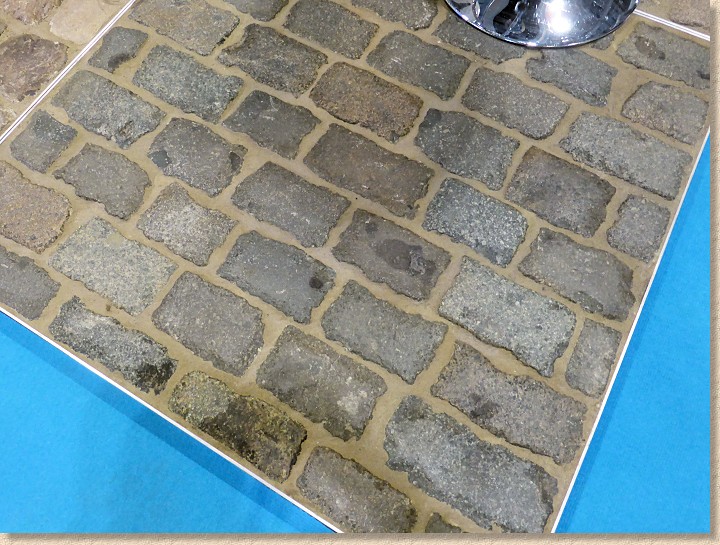
Speaking of continental paving, Dutch concrete paver manufacturer, Schellevis , are in danger of becoming EcoBuild regulars. They provide the distinctive 'aerated' concrete blocks, flags and "Mega Tegels" (Giant Flagstones) that have been steadily attracting more and more attention from the more enlightened designers and contractors. Although popular enough in Europe, the path to British acceptance has been a carefully planned and patient exercise that is beginning to bear significant fruit, with some exciting projects in the pipeline and an intriguing new colour option, "Bronze", a sort of deep browny-black which is certain to delight the garden designers.
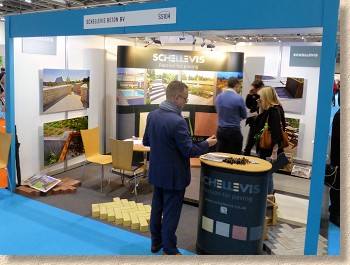
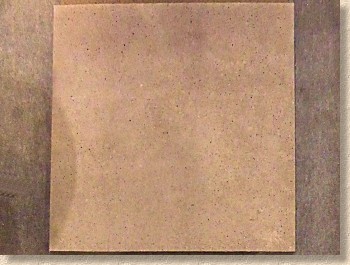
And perhaps we should now think of our traditional clay pavers as 'continental' as the big names are now largely in the hands of European mega-corps who have largely decided our traditional 'British' clays are far too attractive and characterful, so are gradually replacing them with staid, sombre muddy browns from Germany and Holland. Wienerberger , which now owns the archetypal West Midlands manufacturer, Baggeridge, have been sufficiently sensible to hang on to some of the better-selling British clays from that erstwhile range, but a worrying number have been dropped and for someone with a life-long love affair with clays, this is a retrograde step. I'd hate to think we might totally lose our distinctive brindles and blues: our cityscapes would be so much poorer if that happened.
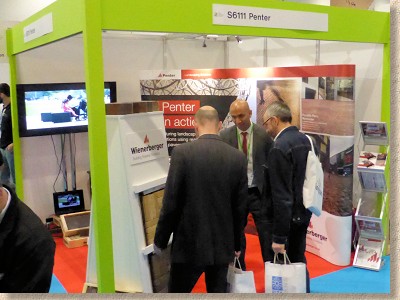
The idea of giving away free mugs emblazoned with the Wienerberger/Penter logo must have seemed like a good promotional idea when they were planning this event, but maybe they weren't aware of the hordes of scavenging students who descend upon EcoBuild like a plague of desert-starved locusts, consuming anything and everything that is freely offered, no matter how irrelevant it might be to their alleged studies. Personally, I'd only let them have a mug (or any other freebie) if they asked a serious and sensible question about the products first. Some of those students were seriously weighed down with plunder and had learned the sum total of bugger all about how we build despite a full day dossing about at ExCel.
SureSet are another perennial at this show, and each time I passed, their stand was busy, busy, busy, so much so that I never got the chance to chat, which is probably a good thing in their mind.
However, not that far away, the other resin-bound show veteran, Addagrip , were getting all over-excited about their new product, Terrabase , which is genuinely worth getting excited about and, without doubt, the best new product I saw all day.
There'll be more written about it later in the season, but for now, the best way to explain it is by saying it's a resin-bound surfacing that doesn't need a base layer. That's right! You can lay it straight onto a sub-base with no need for all that costly concrete or bitmac base which no-one ever gets to see.
There's a little bit more to it: there's a strengthening membrane/grid which goes down more-or-less on top of the sub-base beneath the resin bound aggregate, and the aggregate itself is a bit special, in that it has a much looser appearance, more "rustic" as Addagrip's Tim Hopkin's would have us say, and he's right. It does look more natural, not as smooth and flattened as normal resin-bound, but more akin to how unbound gravel looks.
However, be assured that it is very firmly bound, so no loose chippings, no scuffed and bare spots, no scattered aggregate.
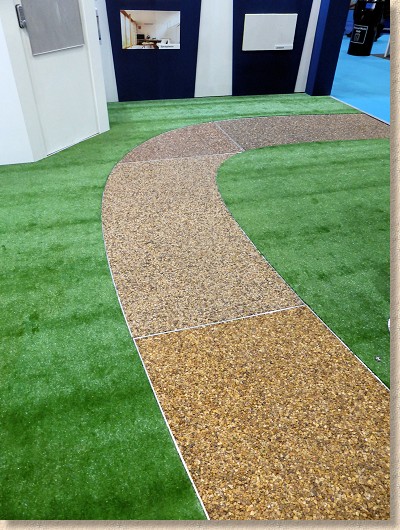
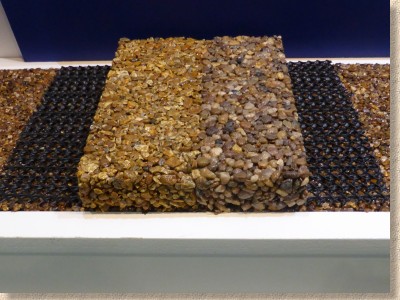
This is going to be of enormous interest to anyone wanting an informal-looking yet low-maintenance, naturalistic pathway. Golf clubs, garden centres, horsey places, nature trails....the potential is almost limitless. And if the simplified build-up, easy installation and stunning good looks aren't enough, then the price will definitely convince them: Addagrip reckon it could be installed for as little as just 65-70 quid per square metre. Wow! Now that *is* a bargain!
I know I've missed a few exhibitors but, to be brutally honest, if you've not been mentioned it's because you had nowt worth mentioning. Sometimes that is because it was same old same old, nothing new to see, and in a few cases, it was because the stand was just completely uninviting, sales reps just sat there with faces like a wet Wednesday in Wigan, making it obvious they didn't want to be there. It's not my job to entertain them, so I leave them to it.
Heading back home, it's the same question as it is every year: was it worth it? Probably not, if I'm being totally honest, but there are far worse days out and there really is no alternative at the moment.
Not enough big names from our trade to really justify the trip down to London, and a real dearth of new ideas, but it does seem to keep attracting just enough medium-sized names to persuade me to attend. I just wish they'd go back to the old idea of having all the hard-landscaping products in one area so I don't have to trudge the length and breadth of Docklands to see everyone.
